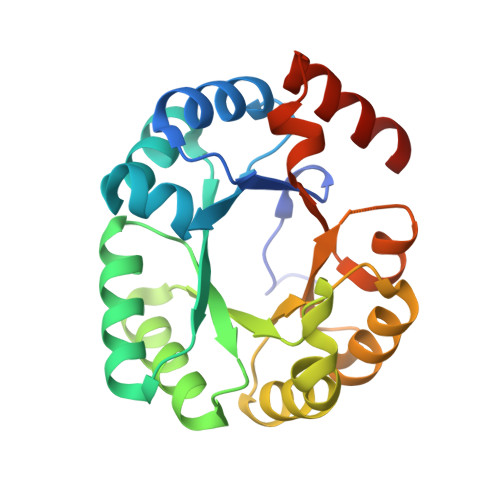Conformational changes in orotidine 5'-monophosphate decarboxylase: "remote" residues that stabilize the active conformation.
Wood, B.M., Amyes, T.L., Fedorov, A.A., Fedorov, E.V., Shabila, A., Almo, S.C., Richard, J.P., Gerlt, J.A.(2010) Biochemistry 49: 3514-3516
- PubMed: 20369850
- DOI: https://doi.org/10.1021/bi100443a
- Primary Citation of Related Structures:
3LHT, 3LHU, 3LHV, 3LHW, 3LHY, 3LHZ, 3LI1, 3LLD, 3LLF, 3LTP, 3LTS, 3LTY, 3LV5, 3LV6, 3M1Z, 3M41, 3M43, 3M44, 3M47, 3M5X, 3M5Y, 3M5Z - PubMed Abstract:
The structural factors responsible for the extraordinary rate enhancement ( approximately 10(17)) of the reaction catalyzed by orotidine 5'-monophosphate decarboxylase (OMPDC) have not been defined. Catalysis requires a conformational change that closes an active site loop and "clamps" the orotate base proximal to hydrogen-bonded networks that destabilize the substrate and stabilize the intermediate. In the OMPDC from Methanobacter thermoautotrophicus, a "remote" structurally conserved cluster of hydrophobic residues that includes Val 182 in the active site loop is assembled in the closed, catalytically active conformation. Substitution of these residues with Ala decreases k(cat)/K(m) with a minimal effect on k(cat), providing evidence that the cluster stabilizes the closed conformation. The intrinsic binding energies of the 5'-phosphate group of orotidine 5'-monophosphate for the mutant enzymes are similar to that for the wild type, supporting this conclusion.
- Department of Biochemistry, University of Illinois, Urbana, Illinois 61801, USA.
Organizational Affiliation:
















